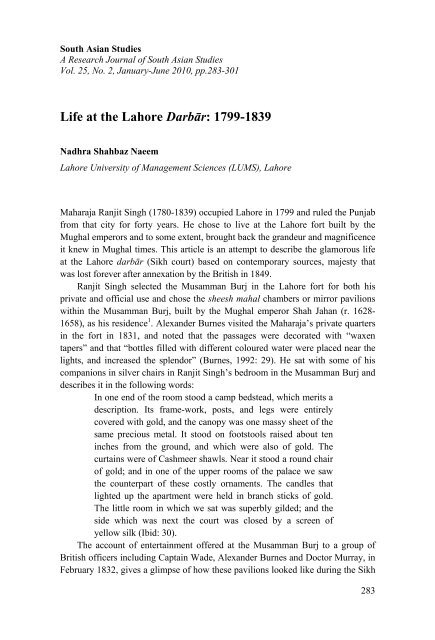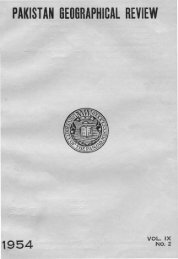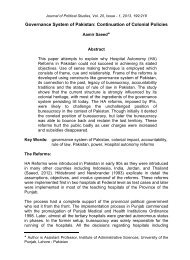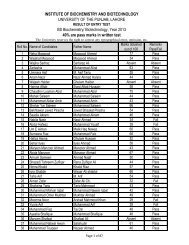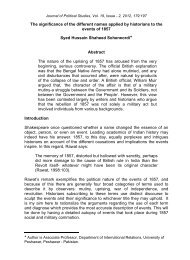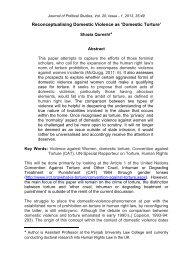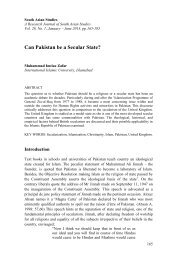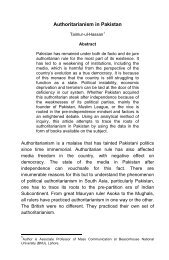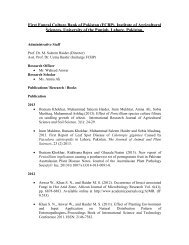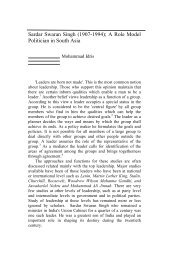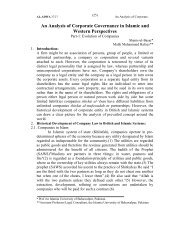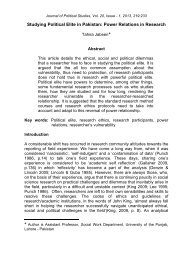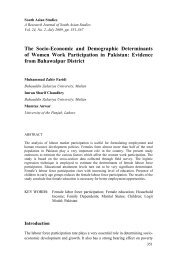Life at the Lahore Darbar: 1799-1839 - University of the Punjab
Life at the Lahore Darbar: 1799-1839 - University of the Punjab
Life at the Lahore Darbar: 1799-1839 - University of the Punjab
Create successful ePaper yourself
Turn your PDF publications into a flip-book with our unique Google optimized e-Paper software.
South Asian Studies<br />
A Research Journal <strong>of</strong> South Asian Studies<br />
Vol. 25, No. 2, January-June 2010, pp.283-301<br />
<strong>Life</strong> <strong>at</strong> <strong>the</strong> <strong>Lahore</strong> Darbār: <strong>1799</strong>-<strong>1839</strong><br />
Nadhra Shahbaz Naeem<br />
<strong>Lahore</strong> <strong>University</strong> <strong>of</strong> Management Sciences (LUMS), <strong>Lahore</strong><br />
Maharaja Ranjit Singh (1780-<strong>1839</strong>) occupied <strong>Lahore</strong> in <strong>1799</strong> and ruled <strong>the</strong> <strong>Punjab</strong><br />
from th<strong>at</strong> city for forty years. He chose to live <strong>at</strong> <strong>the</strong> <strong>Lahore</strong> fort built by <strong>the</strong><br />
Mughal emperors and to some extent, brought back <strong>the</strong> grandeur and magnificence<br />
it knew in Mughal times. This article is an <strong>at</strong>tempt to describe <strong>the</strong> glamorous life<br />
<strong>at</strong> <strong>the</strong> <strong>Lahore</strong> darbār (Sikh court) based on contemporary sources, majesty th<strong>at</strong><br />
was lost forever after annex<strong>at</strong>ion by <strong>the</strong> British in 1849.<br />
Ranjit Singh selected <strong>the</strong> Musamman Burj in <strong>the</strong> <strong>Lahore</strong> fort for both his<br />
priv<strong>at</strong>e and <strong>of</strong>ficial use and chose <strong>the</strong> sheesh mahal chambers or mirror pavilions<br />
within <strong>the</strong> Musamman Burj, built by <strong>the</strong> Mughal emperor Shah Jahan (r. 1628-<br />
1658), as his residence 1 . Alexander Burnes visited <strong>the</strong> Maharaja’s priv<strong>at</strong>e quarters<br />
in <strong>the</strong> fort in 1831, and noted th<strong>at</strong> <strong>the</strong> passages were decor<strong>at</strong>ed with “waxen<br />
tapers” and th<strong>at</strong> “bottles filled with different coloured w<strong>at</strong>er were placed near <strong>the</strong><br />
lights, and increased <strong>the</strong> splendor” (Burnes, 1992: 29). He s<strong>at</strong> with some <strong>of</strong> his<br />
companions in silver chairs in Ranjit Singh’s bedroom in <strong>the</strong> Musamman Burj and<br />
describes it in <strong>the</strong> following words:<br />
In one end <strong>of</strong> <strong>the</strong> room stood a camp bedstead, which merits a<br />
description. Its frame-work, posts, and legs were entirely<br />
covered with gold, and <strong>the</strong> canopy was one massy sheet <strong>of</strong> <strong>the</strong><br />
same precious metal. It stood on footstools raised about ten<br />
inches from <strong>the</strong> ground, and which were also <strong>of</strong> gold. The<br />
curtains were <strong>of</strong> Cashmeer shawls. Near it stood a round chair<br />
<strong>of</strong> gold; and in one <strong>of</strong> <strong>the</strong> upper rooms <strong>of</strong> <strong>the</strong> palace we saw<br />
<strong>the</strong> counterpart <strong>of</strong> <strong>the</strong>se costly ornaments. The candles th<strong>at</strong><br />
lighted up <strong>the</strong> apartment were held in branch sticks <strong>of</strong> gold.<br />
The little room in which we s<strong>at</strong> was superbly gilded; and <strong>the</strong><br />
side which was next <strong>the</strong> court was closed by a screen <strong>of</strong><br />
yellow silk (Ibid: 30).<br />
The account <strong>of</strong> entertainment <strong>of</strong>fered <strong>at</strong> <strong>the</strong> Musamman Burj to a group <strong>of</strong><br />
British <strong>of</strong>ficers including Captain Wade, Alexander Burnes and Doctor Murray, in<br />
February 1832, gives a glimpse <strong>of</strong> how <strong>the</strong>se pavilions looked like during <strong>the</strong> Sikh<br />
283
South Asian Studies 25 (2)<br />
reign. After <strong>the</strong> inspection <strong>of</strong> troops <strong>of</strong> <strong>the</strong> Campoo-i-Muallā (Maharaja’s special<br />
guards) th<strong>at</strong> included a performance by <strong>the</strong> dancing girls in male <strong>at</strong>tires, a grand<br />
reception was arranged for <strong>the</strong> guests. The arrangements included illumin<strong>at</strong>ions<br />
with camphor candles fitted in candle stands th<strong>at</strong> were hung all over <strong>the</strong> place. The<br />
outer and inner walls <strong>of</strong> <strong>the</strong> Musamman Burj were covered with fine fabric,<br />
exquisite gold-embroidered and gold-threaded curtains hung on all windows and<br />
gold-woven carpets were laid in <strong>the</strong> corridors. Tents with silver and gold pl<strong>at</strong>ed<br />
poles were fixed in <strong>the</strong> open space in front <strong>of</strong> <strong>the</strong> Musamman Burj. A goldcanopied<br />
charpoy and gold utensils were displayed and an abundant supply <strong>of</strong><br />
food and drink was available for <strong>the</strong> guests. A dance and music performance was<br />
presented and according to Sohan Lal Suri, <strong>the</strong> sahibs thoroughly enjoyed <strong>the</strong><br />
entertainment (Suri, 2002, 3(i):157-59). The illumin<strong>at</strong>ions and extravagant<br />
decor<strong>at</strong>ions arranged by Khalifa Nuruddin (Maharaja's court physician) were<br />
meant to leave a lasting impression on <strong>the</strong> visitors and <strong>the</strong> Maharaja personally<br />
asked <strong>the</strong>m towards <strong>the</strong> end <strong>of</strong> <strong>the</strong> evening, if <strong>the</strong>y had ever experienced<br />
something similar in Hindustan (Ibid).<br />
All contemporary historical sources talk about <strong>the</strong> grandeur <strong>of</strong> <strong>the</strong> <strong>Lahore</strong><br />
darbār and have recorded countless occasions where Ranjit Singh emph<strong>at</strong>ically<br />
ordered his courtiers and troops to pay special <strong>at</strong>tention to <strong>the</strong>ir <strong>at</strong>tire. He wanted<br />
to build <strong>the</strong> morale <strong>of</strong> his own men with uniforms and discipline in military<br />
exercises comparable to <strong>the</strong> British and impress everyone with <strong>the</strong> grandeur and<br />
riches <strong>of</strong> his court. The chieftains and troops accompanying Ranjit Singh's eldest<br />
son Kharak Singh’s wedding procession in 1811 were ordered to present<br />
<strong>the</strong>mselves in richly decor<strong>at</strong>ed clo<strong>the</strong>s and plumes on <strong>the</strong>ir headgear (Ibid, 2:114).<br />
They were directed to be magnificently dressed in order to "…strike surprise<br />
among <strong>the</strong> onlookers and cre<strong>at</strong>e wonder among <strong>the</strong> spect<strong>at</strong>ors…." (Ibid:116). This<br />
exercise was especially for <strong>the</strong> benefit <strong>of</strong> <strong>the</strong> British <strong>of</strong>ficer Colonel Ochterlony<br />
and <strong>the</strong> Hill Rajas invited for <strong>the</strong> ceremony.<br />
A similar display <strong>of</strong> magnificence mesmerized <strong>the</strong> European visitors when<br />
Lord William Bentick, <strong>the</strong> Governor General <strong>of</strong> India visited <strong>the</strong> Maharaja <strong>at</strong><br />
Ropar in 1831. Raja Dhyan Singh, <strong>the</strong> Prime Minister was asked to make<br />
arrangements th<strong>at</strong> included decor<strong>at</strong>ing <strong>the</strong> camp with velvet and brocade tents,<br />
huge canopies <strong>of</strong> brocade, s<strong>at</strong>in, gold-threaded fabric and tūs (or shahtoosh, top<br />
quality fine wool), as well as excellent floorings. Misr Beli Ram was ordered to<br />
get fine gifts and rare object, with seventy-one garments bound in pashmīna<br />
(costly hand-woven woolen fabric) wrappers, ready to be presented to <strong>the</strong><br />
honorable guest. The pl<strong>at</strong>oons and horsemen were all asked to be dressed in<br />
brocade suits and ornaments, and to stand in a row from <strong>the</strong> portico to <strong>the</strong> bridge<br />
for firing a salute upon <strong>the</strong> chief guest's arrival. The chiefs <strong>at</strong> Sikh court were also<br />
required to wear fabulous clo<strong>the</strong>s and jewelry and were arranged to stand near <strong>the</strong><br />
Maharaja's canopy according to <strong>the</strong>ir ranks (Op.cit, 3(i):112).<br />
284
Nadhra Shahbaz Naeem <strong>Life</strong> <strong>at</strong> <strong>Darbar</strong><br />
G. T. Vigne (2004), <strong>the</strong> famous English traveler, visited <strong>Lahore</strong> in 1837. He<br />
found <strong>the</strong> gold and jewels on <strong>the</strong> Sikh sardārs tempting enough to note in his<br />
memoirs th<strong>at</strong> “There were scarcely any <strong>of</strong> <strong>the</strong> Sirdars around him [Ranjit Singh],<br />
whom one would not have been glad to have pillaged in <strong>the</strong> dark; so bedizened<br />
were <strong>the</strong>y generally with gold and jewels, pearls, emeralds, and <strong>the</strong> rubies <strong>of</strong><br />
Budukshan” (274-5).<br />
A meeting between <strong>the</strong> Maharaja and Lord Auckland took place <strong>at</strong> Ferozepur<br />
on November 29, 1838. Describing <strong>the</strong> magnificence <strong>of</strong> <strong>the</strong> Maharaja's darbār,<br />
Stienbach who accompanied <strong>the</strong> British Governor General, notes th<strong>at</strong> <strong>the</strong> “…Sikh<br />
chieftains, all clinquant, all in gold, or clo<strong>the</strong>d in every diversity <strong>of</strong> colour, and<br />
every imaginable variety <strong>of</strong> picturesque costume, armed to <strong>the</strong> teeth with spears,<br />
saber, shield and lighted m<strong>at</strong>chlock, - scrambled onwards….” (Steinbach, 2005:<br />
140-42). The colonel was mesmerized by <strong>the</strong> opulence and magnificence <strong>of</strong> <strong>the</strong><br />
Indian troops and his awe is evident from his st<strong>at</strong>ement th<strong>at</strong> “<strong>the</strong> scene which now<br />
presented itself is utterly beyond description. All th<strong>at</strong> <strong>the</strong> imagin<strong>at</strong>ion can conceive<br />
<strong>of</strong> human grandeur – all th<strong>at</strong> <strong>the</strong> most exuberant fancy can devise in its endeavour<br />
to portray <strong>the</strong> acme <strong>of</strong> royal splendour – was here embodied forth” (Ibid: 148).<br />
Maharaja Ranjit Singh, in l<strong>at</strong>er years <strong>of</strong> his life is recorded to have worn a<br />
simple dress with few pieces <strong>of</strong> jewelry but during his early reign he also used to<br />
bedeck himself with fancy clo<strong>the</strong>s and jewels to impress <strong>the</strong> visitors. In December<br />
1813, for example, he ordered <strong>the</strong> vakīls <strong>of</strong> Hyderabad to appear in <strong>the</strong> court<br />
before granting <strong>the</strong>m leave and had a very fine carpet laid, and wore a green dress<br />
and turban and "ornaments and armlets beset with jewels"(Op.cit, 2:152). Before<br />
granting audience to Dewān Gudar Mal, <strong>the</strong> vakīl or represent<strong>at</strong>ive <strong>of</strong> Alijah F<strong>at</strong>eh<br />
Khan Barakzai in 1811, <strong>the</strong> Maharaja made sure th<strong>at</strong> <strong>the</strong> guests were impressed<br />
with <strong>the</strong> riches <strong>of</strong> <strong>the</strong> <strong>Lahore</strong> darbār as he put on elabor<strong>at</strong>e clo<strong>the</strong>s and fine<br />
jewelry, ordered a superior quality carpet to be laid out and s<strong>at</strong> in a gold chair<br />
(Ibid:111).<br />
The magnificence <strong>of</strong> <strong>the</strong> Sikh court was echoed by a silver bungalow Ranjit<br />
Singh had ordered for holding court away from <strong>the</strong> pavilions <strong>of</strong> Musamman Burj.<br />
It was set up for <strong>the</strong> first time near a “northward garden” near <strong>the</strong> <strong>Lahore</strong> fort and<br />
he entered it <strong>at</strong> an auspicious moment calcul<strong>at</strong>ed by <strong>the</strong> court astrologers (Ibid:<br />
289). In 1826 or 1827, while <strong>the</strong> Maharaja was in Amritsar due to ill health, he<br />
ordered <strong>the</strong> silver bungalow to be brought to Amritsar for <strong>the</strong> Dussehrā<br />
celebr<strong>at</strong>ions 2 . It was fixed on <strong>the</strong> bank <strong>of</strong> <strong>the</strong> stream in <strong>the</strong> village Tang. Th<strong>at</strong> <strong>the</strong><br />
bungalow was double-storied is evident because on October 29, 1831, during <strong>the</strong><br />
display <strong>of</strong> Maharaja's military drills <strong>at</strong> <strong>the</strong> meeting with Lord William Bentick <strong>at</strong><br />
Ropar, <strong>the</strong> Governor General was taken to <strong>the</strong> “upper storey” <strong>of</strong> <strong>the</strong> silver<br />
bungalow. It is a probable th<strong>at</strong> <strong>the</strong> “bungalow on wheels” described by Fakir<br />
Waheeduddin refers to <strong>the</strong> same one. He writes th<strong>at</strong> it had silver walls, a shawl<br />
canopy and was furnished with carpets, cushions, curtains and chandeliers and was<br />
pulled by eight elephants (Waheeduddin, 1965: 159). Ano<strong>the</strong>r novelty recorded by<br />
285
South Asian Studies 25 (2)<br />
Suri is a bo<strong>at</strong> th<strong>at</strong> Ranjit Singh ordered th<strong>at</strong> was shaped like a peacock (Op.cit,<br />
2:427). O<strong>the</strong>r curiosities p<strong>at</strong>ronized by <strong>the</strong> <strong>Lahore</strong> darbār are briefly described;<br />
Kharak Singh’s wedding procession had a moving throne and a model <strong>of</strong> <strong>the</strong><br />
Shalimar Gardens th<strong>at</strong> was carried on <strong>the</strong> shoulders <strong>of</strong> about one hundred men and<br />
Rani Nakain, <strong>the</strong> groom's mo<strong>the</strong>r s<strong>at</strong> in a chariot th<strong>at</strong> was set with jewels and had a<br />
crown over it (Ibid:117). At <strong>the</strong> time <strong>of</strong> Kharak Singh's son Naunehal Singh’s<br />
wedding in February 1837, Henry Fane noted with approval <strong>the</strong> trees <strong>at</strong> <strong>the</strong> fort <strong>of</strong><br />
Bhangian (Amritsar) bearing “fruit covered with gold and silver leaves” hanging<br />
from <strong>the</strong> branches (Op.cit, 3(iii):440). Most <strong>of</strong> <strong>the</strong> novelties cre<strong>at</strong>ed for <strong>the</strong><br />
Maharaja and <strong>the</strong> elite Sikh courtiers are not extant and can only be reconstructed<br />
through <strong>the</strong>ir accounts in contemporary historical sources.<br />
The lists <strong>of</strong> items given away as <strong>of</strong>ferings and presents inform us <strong>of</strong> <strong>the</strong> riches<br />
th<strong>at</strong> circul<strong>at</strong>ed in Sikh society. Luxury items made <strong>of</strong> silver and gold including<br />
utensils, beds and chairs, votive objects, picture frames used for sacred images,<br />
gold-threaded horse saddles, silver and gold howdās or elephant se<strong>at</strong>s are<br />
mentioned. Pashmīna and gold woven fabrics appear to have been a gre<strong>at</strong> favorite<br />
along with different kinds <strong>of</strong> cottons and silks. Jewelry was worn extravagantly by<br />
both men and women and names <strong>of</strong> a few pieces are mentioned by Suri like <strong>the</strong><br />
chaura pāīn, ponchiān, bāzooband, qashaqa, damnī and mālā (Ibid: 432).<br />
Contemporary jewelry pieces are shown in nineteenth century illustr<strong>at</strong>ions for <strong>the</strong><br />
copies <strong>of</strong> Ain-i-Akbari (figure 1).<br />
Fig.1: Ain-i-Akbari (The Chronicles <strong>of</strong> Emperor Akbar), <strong>Lahore</strong>, Pakistan. Ink, pigment, gold leaf<br />
paper, c. 1822. Collection <strong>of</strong> Royal Ontario Museum, Toronto, Canada.<br />
(2006.70.1_16_page09_det)<br />
The frescoes in <strong>the</strong> interior <strong>of</strong> Maharaja Ranjit Singh’s Samadhī in <strong>Lahore</strong>,<br />
built around <strong>the</strong> middle <strong>of</strong> <strong>the</strong> nineteenth century, present excellent examples <strong>of</strong><br />
<strong>the</strong> ambience <strong>of</strong> <strong>the</strong> <strong>Lahore</strong> darbār. Here <strong>the</strong> mythological scenes are illustr<strong>at</strong>ed<br />
286
Nadhra Shahbaz Naeem <strong>Life</strong> <strong>at</strong> <strong>Darbar</strong><br />
with a firsthand knowledge <strong>of</strong> opulence and grandeur, showing even <strong>the</strong><br />
shepherds, ascetics and maidservants laden with jewelry and wearing richly<br />
embellished dresses.<br />
The pomp and pageantry <strong>of</strong> <strong>the</strong> <strong>Lahore</strong> darbār was fully displayed during<br />
popular Hindu religious festivals. Dussehrā is celebr<strong>at</strong>ed in memory <strong>of</strong> <strong>the</strong> Hindu<br />
god Rama's victory over Ravanna; an occasion th<strong>at</strong> reinforces <strong>the</strong> triumph <strong>of</strong><br />
virtue over evil. Maharaja Ranjit Singh celebr<strong>at</strong>ed <strong>the</strong> event every year with gre<strong>at</strong><br />
festivity and ordered his courtiers to particip<strong>at</strong>e with equal fervor. He began <strong>the</strong><br />
celebr<strong>at</strong>ions with <strong>the</strong> worship <strong>of</strong> <strong>the</strong> horse and <strong>the</strong> sword (Op.cit, 2:495). An<br />
explan<strong>at</strong>ion <strong>of</strong> this act is found in H. T. Princep’s st<strong>at</strong>ement: “Guru Govind [<strong>the</strong><br />
tenth Sikh guru] devoted his followers to steel, and hence <strong>the</strong> worship <strong>of</strong> <strong>the</strong><br />
sword, as well as its employment against both Mahomedans (sic) and Hindus”<br />
(Princep, 1846, 1:122). James Tod notes th<strong>at</strong> “Karga Shapna” or worship <strong>of</strong> <strong>the</strong><br />
sword is a Rajput tradition and is “essentially martial” (Tod, 1877, 1:458). O<strong>the</strong>r<br />
activities during <strong>the</strong> Sikh period included putting up effigies <strong>of</strong> <strong>the</strong> characters <strong>of</strong><br />
<strong>the</strong> epic Ramayana and a discharge <strong>of</strong> <strong>the</strong> topkhanā (canons). In 1811, <strong>the</strong><br />
festivities included a mock b<strong>at</strong>tle <strong>of</strong> <strong>the</strong> conquest <strong>of</strong> Lanka by <strong>the</strong> Maharaja’s<br />
armed troops th<strong>at</strong> resulted in a gre<strong>at</strong> confusion leaving countless injured and many<br />
dead (Op.cit, 2:109).<br />
Dussehrā in V. S. Samb<strong>at</strong> 1883/1826 A. D. was celebr<strong>at</strong>ed <strong>at</strong> <strong>the</strong> village Tang,<br />
near Amritsar where <strong>the</strong> Maharaja’s silver bungalow was set up after being<br />
brought from <strong>Lahore</strong> (Ibid: 408). Prince Sher Singh, one <strong>of</strong> Ranjit Singh's sons,<br />
“got a hint from <strong>the</strong> Maharaj” to erect <strong>the</strong> symbolic “Lanka" in a "graceful and<br />
stylish manner". The carpet-layers were ordered to spread fine floorings and to<br />
affix tents without poles, woven with gold and silver threads and brocade and gold<br />
threaded canopies with golden poles, near <strong>the</strong> Maharaja’s silver bungalow. The<br />
daroghā or in-charge <strong>of</strong> <strong>the</strong> stables was ordered to present <strong>the</strong> best horses<br />
decor<strong>at</strong>ed with gold and bejeweled harnesses and <strong>the</strong> in-charge <strong>of</strong> elephants was<br />
similarly ordered to bring fully decor<strong>at</strong>ed huge elephants. Prince Sher Singh, <strong>the</strong><br />
chieftains and <strong>the</strong> troops were directed to put on fine clo<strong>the</strong>s and appear for<br />
inspection before <strong>the</strong> Maharaja (Ibid: 409). During <strong>the</strong> Dussehrā festivities, <strong>the</strong><br />
chieftains along with <strong>the</strong>ir troops <strong>of</strong> horsemen wore steel armors inlaid with gold<br />
and enameled golden th<strong>at</strong> was highly polished. Their bright dresses were made <strong>of</strong><br />
gold-threaded cloth, brocades and s<strong>at</strong>ins <strong>of</strong> various colors (Ibid: 455).<br />
In March 1832, prepar<strong>at</strong>ions were made for a grand Holī festival. Holī is a<br />
Hindu spring festival celebr<strong>at</strong>ed by throwing colored dyes on each o<strong>the</strong>r. Misr Beli<br />
Ram was ordered to give Rs. 500/- every day to Raja Hira Singh (Raja Dhyan<br />
Singh's son and a favorite <strong>of</strong> <strong>the</strong> Maharaja) for <strong>the</strong> prepar<strong>at</strong>ions <strong>of</strong> <strong>the</strong> event and<br />
<strong>the</strong> staff responsible for floorings was instructed to make arrangements in <strong>the</strong><br />
garden <strong>of</strong> Shah Balāwal. The merriment went on for three days; March 15 to 17,<br />
1832. The Singhs (Sikh sardārs) and <strong>the</strong> troops <strong>of</strong> Campoo-i muallā (According to<br />
Lafont, name given to <strong>the</strong> regular units which did not belong to <strong>the</strong> Fauj-i khās or<br />
287
South Asian Studies 25 (2)<br />
to ano<strong>the</strong>r French brigade) were made to stand opposite each o<strong>the</strong>r to playfully<br />
fight with <strong>the</strong> lac dye in sprinklers while <strong>the</strong> dancing girls presented <strong>the</strong>ir dance<br />
and songs. The Maharaja l<strong>at</strong>er held a darbār <strong>at</strong> <strong>the</strong> garden <strong>of</strong> Chota Ram where all<br />
<strong>the</strong> vakīls, nawābs and chieftains were invited for <strong>the</strong> celebr<strong>at</strong>ions. They played<br />
with <strong>the</strong> lac dye, sprinkled rose w<strong>at</strong>er and saffron. At <strong>the</strong> end <strong>of</strong> <strong>the</strong> celebr<strong>at</strong>ions,<br />
<strong>the</strong> dignitaries were awarded robes <strong>of</strong> honor (Op.cit, 3(ii):170-71).<br />
Basant is ano<strong>the</strong>r Hindu spring festival, dedic<strong>at</strong>ed to <strong>the</strong> goddess Sarasv<strong>at</strong>i.<br />
During Ranjit Singh’s times, celebr<strong>at</strong>ions usually took place <strong>at</strong> <strong>the</strong> mausoleum <strong>of</strong><br />
Madho Lal Husain, <strong>at</strong> <strong>Lahore</strong>. For Basant in 1825, <strong>the</strong> Maharaja ordered all<br />
horsemen and pl<strong>at</strong>oons to wear yellow costumes and to form lines all <strong>the</strong> way<br />
from <strong>the</strong> Delhi G<strong>at</strong>e to <strong>the</strong> mausoleum. The Maharaja came out <strong>of</strong> <strong>the</strong> fort,<br />
performed suchetā (ablutions) and inspected <strong>the</strong> parade <strong>of</strong> <strong>the</strong> troops. He <strong>the</strong>n<br />
went to <strong>the</strong> mausoleum and s<strong>at</strong> under a high yellow canopy and enjoyed w<strong>at</strong>ching<br />
<strong>the</strong> fair for two to three hours before returning to <strong>the</strong> fort (Ibid, 2:388). A couple <strong>of</strong><br />
years l<strong>at</strong>er on Basant day <strong>at</strong> <strong>the</strong> same venue, tents, screens and canopies <strong>of</strong> yellow<br />
color, beautifully woven in wool, were set up which <strong>the</strong> Maharaja had recently<br />
received from Kashmir. Chieftains, pl<strong>at</strong>oons and <strong>the</strong> horsemen were all ordered to<br />
wear yellow costumes and to stand in rows from <strong>the</strong> Delhi G<strong>at</strong>e to <strong>the</strong> tomb for<br />
inspection. After his usual inspection, <strong>the</strong> Maharaja took his se<strong>at</strong> in <strong>the</strong> gold chair<br />
in his tent <strong>at</strong> <strong>the</strong> tomb (Ibid: 438).<br />
These festivities and royal entertainments also included dance performances<br />
by <strong>the</strong> dancing girls frequently mentioned by contemporary sources. Especially<br />
noteworthy is Ranjit Singh's troop <strong>of</strong> female “Amazons” or <strong>the</strong> zenanā pl<strong>at</strong>oon.<br />
Each one <strong>of</strong> <strong>the</strong>se “soldiers” carried a bow and arrow in hand and had a sword by<br />
her waist during performance (Ibid, 3(i):114-15). The band consisted <strong>of</strong> thirty or<br />
forty singing and dancing girls chosen for <strong>the</strong>ir "beauty <strong>of</strong> face and figure,<br />
playfulness and agility" (Op.cit, 1965: 178). The Real Ranjit Singh gives <strong>the</strong>ir<br />
description in <strong>the</strong> following words:<br />
A lemon-yellow banarsi turban with a bejeweled crest; a dark<br />
green jumper over a blue s<strong>at</strong>in gown, fastened with a gold<br />
belt; deep crimson skin-tight pyjamas <strong>of</strong> gulbadan silk; and a<br />
pair <strong>of</strong> pointed golden shoes. As for jewelry, <strong>the</strong>y wore a pair<br />
<strong>of</strong> gold earrings set with stones, a diamond nose stud, a pair <strong>of</strong><br />
gold bracelets and a ruby ring on <strong>the</strong> middle finger (Ibid).<br />
The Maharaja was very fond <strong>of</strong> w<strong>at</strong>ching dance performances and sometimes<br />
spent all day or most <strong>of</strong> <strong>the</strong> night in such entertainments, if we are to believe <strong>the</strong><br />
newsletters published as Events <strong>at</strong> <strong>the</strong> Court <strong>of</strong> Ranjit Singh, 1810-1817 (Garrette and<br />
Chopra, 1986: 11-12, 26, 53, 56, 74 etc). But <strong>the</strong>se sources also record some <strong>of</strong> his<br />
rare solitary moments away from merriment and expeditions th<strong>at</strong> were spent in<br />
listening to one Attar Khan playing <strong>the</strong> flute, especially on rainy evenings (Ibid:<br />
70, 96, 101, 186, 189 etc). He is also noted to have pleased himself with a ramble<br />
in heavy rainfall in summers while enjoying <strong>the</strong> sight <strong>of</strong> fountains (Ibid: 83).<br />
288
Nadhra Shahbaz Naeem <strong>Life</strong> <strong>at</strong> <strong>Darbar</strong><br />
Ranjit Singh’s martial impression is fur<strong>the</strong>r s<strong>of</strong>tened by his fondness for<br />
gardens. Although <strong>the</strong> outer precincts <strong>of</strong> <strong>Lahore</strong> still displayed ruins with<br />
abandoned mosques and mausoleums in <strong>the</strong> nineteenth century as st<strong>at</strong>ed by<br />
various European travelers and visitors, <strong>the</strong> main city boasted many gardens (Barr,<br />
1844: 66). The Shalimar Gardens in <strong>the</strong> outskirts <strong>of</strong> nineteenth century <strong>Lahore</strong> was<br />
not only visited for enjoying <strong>the</strong> remarkable beauty but it also <strong>of</strong>fered a place for<br />
journey-break on <strong>the</strong> Maharaja's frequent visits to Amritsar. He used to put up <strong>at</strong><br />
<strong>the</strong> Gardens for days while proceeding towards <strong>the</strong> Holy City or upon entering<br />
<strong>Lahore</strong> on his way back. The pleasure <strong>the</strong> Maharaja derived from <strong>the</strong> Gardens is<br />
evident from Suri's account <strong>of</strong> September 1818, given below:<br />
The Maharaja ordered <strong>the</strong> march <strong>of</strong> his royal standards from<br />
<strong>the</strong> village <strong>of</strong> Sourian, and, by way <strong>of</strong> <strong>the</strong> bridge <strong>of</strong> Kakargill<br />
boarded <strong>the</strong> bo<strong>at</strong>s and came over to Shalabagh. As <strong>the</strong> said<br />
garden brightened <strong>the</strong> eyes <strong>of</strong> every body on account <strong>of</strong> its<br />
abundant trees, plenty <strong>of</strong> roses, fruit bearing trees and w<strong>at</strong>er<br />
channels, <strong>the</strong> Maharaja was pleased and liked to stay <strong>the</strong>re for<br />
a few days (Op. cit, 2:265).<br />
Sohan Lal Suri mentions <strong>the</strong> Garden in different names; Shalamār, Shalabāgh<br />
or Shehla Bāgh and also as Shualā-i-māh or <strong>the</strong> "spark <strong>of</strong> <strong>the</strong> moon" (Ibid: 54). An<br />
explan<strong>at</strong>ion for this variety <strong>of</strong> names is found in Sita Ram Kohli's account where<br />
he refers to Dewan Amar N<strong>at</strong>h's Zafarnama-i-Ranjit Singh, and notes th<strong>at</strong> in 1803,<br />
<strong>the</strong> Maharaja while strolling in <strong>the</strong> Gardens with his companions argued about <strong>the</strong><br />
meaning <strong>of</strong> <strong>the</strong> name “Shalamār”. According to <strong>the</strong> Maharaja, <strong>the</strong> literal meaning<br />
<strong>of</strong> <strong>the</strong> word in <strong>Punjab</strong>i was "God's strike" and <strong>the</strong>refore it was unsuitable for a<br />
garden. The courtiers tried to make him understand th<strong>at</strong> this was a Turkish word<br />
th<strong>at</strong> meant "farh<strong>at</strong> bakhsh" or refreshing, but Ranjit Singh dismissed <strong>the</strong>m saying<br />
th<strong>at</strong> <strong>the</strong> <strong>Punjab</strong> was not inhabited by Turks, <strong>the</strong>refore a name understandable in <strong>the</strong><br />
local language needed to be adopted and th<strong>at</strong> was to be Shalā Bāgh (Kohli, 2004:<br />
77).<br />
Captain Wade, <strong>the</strong> British political agent <strong>at</strong> Ludhiana, visited <strong>Lahore</strong> in June<br />
1838 prior to <strong>the</strong> Governor General Lord Auckland's visit in January <strong>1839</strong>. The<br />
Captain appreci<strong>at</strong>ed <strong>the</strong> delightful Shalimar Gardens but pointed out th<strong>at</strong><br />
dilapid<strong>at</strong>ion marred its beauty. He suggested th<strong>at</strong> repairs be made before <strong>the</strong><br />
Governor General's forthcoming visit, to which <strong>the</strong> Maharaja readily agreed and<br />
ordered Khalifa Nuruddin to immedi<strong>at</strong>ely visit <strong>the</strong> Gardens and submit a report<br />
(Op.cit, 3(iv):195-96).<br />
Besides <strong>the</strong> Shalimar Gardens, Umd<strong>at</strong>-ut-Tawarikh frequently mentions <strong>the</strong><br />
Hazuri Bāgh th<strong>at</strong> lies between <strong>the</strong> Badshahi Mosque and <strong>the</strong> Alamgirī G<strong>at</strong>e <strong>of</strong> <strong>the</strong><br />
<strong>Lahore</strong> fort. Sohan Lal Suri records th<strong>at</strong> this garden was laid out <strong>at</strong> <strong>the</strong> orders <strong>of</strong><br />
<strong>the</strong> Maharaja <strong>at</strong> <strong>the</strong> beginning <strong>of</strong> <strong>the</strong> new Bikrami year 1870 (April 1813), and<br />
expert gardeners were engaged for <strong>the</strong> purpose (Ibid, 2:136). Following <strong>the</strong><br />
289
South Asian Studies 25 (2)<br />
Mughal tradition, a marble baradarī was constructed in <strong>the</strong> centre <strong>of</strong> <strong>the</strong> garden<br />
(figure 2).<br />
290<br />
Fig. 2: Hazuri Bāgh, <strong>Lahore</strong>. (Photo: 2006)<br />
Fig. 2: Hazuri Bagh Pavilion, <strong>Lahore</strong>, Pakistan. (Photo: 2006)<br />
An Englishman, Lieut. William Barr visited <strong>Lahore</strong> in February <strong>1839</strong>. His<br />
detailed account <strong>of</strong> <strong>the</strong> Hazuri Bāgh baradarī given below helps reconstruct <strong>the</strong><br />
original structure:<br />
In <strong>the</strong> center <strong>of</strong> this square [Hazuri Bāgh], which is laid out in<br />
gardens and terraces, is an elegant little building, erected by<br />
<strong>the</strong> Maharaja, with marble pilfered from <strong>the</strong> tombs <strong>of</strong> Jahangir<br />
and his wazir [Empress Nurjahan's bro<strong>the</strong>r Asif Jah], where he<br />
transacts business in <strong>the</strong> hot season. The lower apartment is<br />
fourteen feet square, ornamented with looking-glass, gilding,<br />
and colours, most harmoniously blended, and extremely rich.<br />
Light is admitted through Saracenic arches on pillars, and a<br />
verandah, eight feet broad, with a ceiling embellished in <strong>the</strong><br />
same style <strong>of</strong> pr<strong>of</strong>usion, encompasses <strong>the</strong> whole, which is built<br />
on a chabootra some four <strong>of</strong> five feet above <strong>the</strong> ground. We<br />
ascended to an upper room <strong>of</strong> similar size and shape, but even<br />
more beautifully and gorgeously ornamented; <strong>the</strong> four doors<br />
being decor<strong>at</strong>ed with ivory, inlaid in various devices, each<br />
being different from <strong>the</strong> o<strong>the</strong>r, and all arranged with much<br />
taste. There is also an apartment under-ground, where <strong>the</strong><br />
Maharaja takes refuge from <strong>the</strong> hot winds, and during <strong>the</strong><br />
hours <strong>of</strong> recre<strong>at</strong>ion admits a few <strong>of</strong> his most intim<strong>at</strong>e friends<br />
(Op.cit, 1844: 98).<br />
Suri's accounts mention th<strong>at</strong> <strong>the</strong> Maharaja used <strong>the</strong> baradarī not only for<br />
recre<strong>at</strong>ional purposes but also to celebr<strong>at</strong>e various festivals (op cit, 2:441). The<br />
pavilion lost its upper storey on July 19, 1932 and <strong>the</strong> damaged portion was<br />
removed to <strong>the</strong> fort (Aijazuddin, 2004: 74). Presently, <strong>the</strong> baradarī is a singlestoried<br />
structure and is in a fairly good condition.
Nadhra Shahbaz Naeem <strong>Life</strong> <strong>at</strong> <strong>Darbar</strong><br />
Contemporary sources also record several occasions when <strong>the</strong> Maharaja<br />
ordered <strong>the</strong> laying out <strong>of</strong> gardens and construction <strong>of</strong> baradarīs. In November<br />
1819, <strong>the</strong> Maharaja ordered Fakir Imamuddin, thanedār (in-charge) <strong>of</strong> Gobindgarh<br />
fort <strong>at</strong> Amritsar, to lay out a garden (Rambāgh) outside <strong>the</strong> k<strong>at</strong>rā (or <strong>the</strong> locality<br />
generally occupied) <strong>of</strong> Jai Singh Kanhaya 3 , and th<strong>at</strong> it should be similar to <strong>the</strong><br />
Shalimar Gardens (Op.cit, 2:312). The garden complex has a double-storied red<br />
sandstone g<strong>at</strong>eway and buildings laid out in <strong>the</strong> chaupār (four sections) p<strong>at</strong>tern<br />
(Khanna, 2001: 116). Ranjit Singh’s summer palace stands in <strong>the</strong> center <strong>of</strong> <strong>the</strong><br />
garden with four ancillary buildings on <strong>the</strong> cardinal axes. The Garden still exists<br />
but is now called <strong>the</strong> Company Bāgh and <strong>the</strong> buildings are used for different<br />
purposes. The Summer Palace is now used as Maharaja Ranjit Singh Museum<br />
(figure 3).<br />
Fig. 3: Rāmbāgh Palace, Amritsar, India. (Photo: 2006)<br />
There are quite a few references in <strong>the</strong> chronicles <strong>of</strong> priv<strong>at</strong>e gardens laid out<br />
and owned by <strong>the</strong> sardārs and <strong>the</strong> elite. The Maharaja frequently visited <strong>the</strong>se<br />
gardens (bāghs) and occasionally celebr<strong>at</strong>ed festivals or held court. Suri st<strong>at</strong>es th<strong>at</strong><br />
"he indulged in walks and strolls <strong>the</strong>re among <strong>the</strong> blossoms and rosebuds which<br />
had been set in graceful order by <strong>the</strong> gardeners" (op cit, 2:415). Among <strong>the</strong> most<br />
frequently mentioned besides Shalimar Gardens are <strong>the</strong> gardens <strong>of</strong> Chota Ram,<br />
Jamadar Khushal Singh, Amb Dhoorewalā and Anguri Bāgh. These gardens also<br />
had small pavilions in <strong>the</strong>m. In September 1827, ahalkārs or <strong>the</strong> <strong>of</strong>ficers <strong>of</strong> <strong>the</strong><br />
concerned department were issued orders to "get ready a newly founded Baradari<br />
in perfect strength toge<strong>the</strong>r with a fine garden on <strong>the</strong> bank <strong>of</strong> river [Ravi]" (Ibid:<br />
430).<br />
The chronicles <strong>of</strong> 1832 shed interesting light on <strong>the</strong> architectural activities th<strong>at</strong><br />
prevailed during <strong>the</strong> Sikh rule over <strong>the</strong> <strong>Punjab</strong>. Suri records:<br />
As <strong>the</strong> Maharaja always had a gre<strong>at</strong> liking for building lovely<br />
new buildings, he proposed <strong>the</strong> building <strong>of</strong> a Baradari <strong>at</strong><br />
Kaulsar [Amritsar] during <strong>the</strong>se days. He, <strong>the</strong>refore, appointed<br />
F<strong>at</strong>eh Khan, son <strong>of</strong> Mian Elahi Bakhsh, for fetching stone<br />
from <strong>Lahore</strong>. Rs. 50 were given to him for his personal use,<br />
291
South Asian Studies 25 (2)<br />
Rs. 10 were given to his Munshi and Rs. 20 for cartage (Ibid,<br />
3(ii):176).<br />
Suri recounts in 1826 th<strong>at</strong> <strong>the</strong> Maharaja ordered bungalows to be built "all<br />
along <strong>the</strong> way from Adinanagar to Amritsar" in all probability as halting places for<br />
himself (Ibid, 2:406). Shortly before passing <strong>the</strong>se orders, he is reported to have<br />
fallen ill after his visit to <strong>the</strong> Jawalamukhi Temple in <strong>the</strong> Hills and had to rush<br />
back to Adinanagar, and from <strong>the</strong>re to Amritsar (Ibid: 405). Henry Fane also notes<br />
in his memoirs th<strong>at</strong> since <strong>the</strong> Maharaja is constantly on <strong>the</strong> move, he has built<br />
single rooms along <strong>the</strong> gre<strong>at</strong> roads to seek a cool shelter when <strong>the</strong> he<strong>at</strong> becomes<br />
unbearable in a tent (Fane, 1842, 1:150). One <strong>of</strong> <strong>the</strong> few extant baradarīs built by<br />
Ranjit Singh is in <strong>the</strong> Shalimar Gardens. It was occupied by William Moorcr<strong>of</strong>t for<br />
some time who mentions it in his memoirs 4 . He stayed <strong>at</strong> <strong>the</strong> small baradarī th<strong>at</strong><br />
was furnished with a cooling device and describes it in <strong>the</strong> following words:<br />
May 6. I started <strong>at</strong> three, and <strong>at</strong> nine reached Shahlimar, <strong>the</strong><br />
large garden laid out by order <strong>of</strong> Shah Jehan, where I took up<br />
my abode in a chamber erected by <strong>the</strong> Raja close to a well,<br />
and a reservoir which it supplies, and from which jets d' eau<br />
are made to play so near to <strong>the</strong> apartment as to cool <strong>the</strong> air <strong>at</strong><br />
its entrance (Moorcr<strong>of</strong>t and Trebeck, 2004, 1:91).<br />
4).<br />
292<br />
The building and its cooling well are visible today but in need <strong>of</strong> repair (figure<br />
Fig. 4: Baradarī <strong>at</strong> <strong>the</strong> Shalimar Gardens, <strong>Lahore</strong>. (Photo: 2006)<br />
In addition to laying out gardens with baradarīs, <strong>the</strong> Sikh monarch and his<br />
sardārs also built large mansions or havelīs in <strong>Lahore</strong>. Sections <strong>of</strong> two large havelī<br />
complexes, Jamadar Khushal Singh's havelī in Chūna Mandī and Naunehal Singh's<br />
havelī inside <strong>the</strong> Mori G<strong>at</strong>e survive in <strong>the</strong>ir original form and are used today as a<br />
girls’ college and a girls’ school, respectively.<br />
Jamadar Khushal Singh's havelī was a part <strong>of</strong> a triangular site occupying 2.7<br />
hectares, inside <strong>the</strong> Masitī G<strong>at</strong>e. Today <strong>the</strong> site includes three main structures, two
Nadhra Shahbaz Naeem <strong>Life</strong> <strong>at</strong> <strong>Darbar</strong><br />
<strong>of</strong> <strong>the</strong> Sikh period and <strong>the</strong> third d<strong>at</strong>eable to <strong>the</strong> British. The largest <strong>of</strong> <strong>the</strong> three<br />
structures, <strong>the</strong> havelī itself, covered almost one hectare and <strong>the</strong> construction was<br />
probably started in 1817 (PEPA, 1993: 69-83). A contemporary record<br />
indic<strong>at</strong>es th<strong>at</strong> Maharaja Ranjit Singh gave five hundred wooden beams to <strong>the</strong><br />
Jamadar in August <strong>of</strong> th<strong>at</strong> year for <strong>the</strong> construction <strong>of</strong> a mansion (Op.cit, 1986:<br />
275). The large havelī is a huge rectangle measuring almost a hectare, and a portal<br />
th<strong>at</strong> faces east. A square garden behind <strong>the</strong> portal was surrounded by chambers<br />
and subterranean rooms (used during <strong>the</strong> summers). The women's quarters or<br />
zenanā were situ<strong>at</strong>ed on <strong>the</strong> sou<strong>the</strong>rn and south-eastern sides <strong>of</strong> <strong>the</strong> courtyard. The<br />
nor<strong>the</strong>rn side held <strong>the</strong> b<strong>at</strong>hs or hammāms as well as <strong>the</strong> elephant stables or feelkhanā<br />
(op cit, 1993: 78). Kanhaya Lal describes <strong>the</strong> l<strong>of</strong>ty sou<strong>the</strong>rn and westerns<br />
walls <strong>of</strong> <strong>the</strong> havelī as almost equal in height to <strong>the</strong> walls <strong>of</strong> <strong>the</strong> <strong>Lahore</strong> fort -<br />
giving <strong>the</strong> havelī <strong>the</strong> appearance <strong>of</strong> a second fort (Lal, 2006: 308).<br />
Kanhaya Lal also writes <strong>of</strong> a havelī built for Naunehal Singh in 1837. It was<br />
one <strong>of</strong> <strong>the</strong> grandest edifices <strong>of</strong> <strong>Lahore</strong> with countless courtyards, subterranean<br />
rooms and buildings sumptuously decor<strong>at</strong>ed with gold-work on <strong>the</strong> ceilings. He<br />
also refers to “a towering building <strong>of</strong> glass” th<strong>at</strong> nei<strong>the</strong>r survives, nor mentioned in<br />
o<strong>the</strong>r accounts (Ibid, 306). Including <strong>the</strong> subterranean floor, it is a five-storied<br />
building, 124 feet long, 97.5 feet wide and 51 feet high (Khokhar, 1999: 77). A<br />
square courtyard in <strong>the</strong> centre is surrounded by three floors <strong>of</strong> rooms. The first<br />
floor has eleven rooms, thirteen on <strong>the</strong> second and nine on <strong>the</strong> third (Ibid). Above<br />
<strong>the</strong> third floor <strong>of</strong> Naunehal Singh’s havelī, a single small oblong room is built on<br />
<strong>the</strong> north-western corner as a barsātī and is decor<strong>at</strong>ed with frescoes 6 . The east and<br />
west facades <strong>of</strong> <strong>the</strong> havelī are decor<strong>at</strong>ed in different m<strong>at</strong>erials: <strong>the</strong> east facade<br />
boasts <strong>of</strong> tastefully executed monochrome cut-brick and masonry as well as relief<br />
work whereas <strong>the</strong> west side shows colorful frescoes (figures 5 - 6).<br />
Fig. 5: East façade, havelī Naunehal Singh, <strong>Lahore</strong>. (Photo: 2006)<br />
293
South Asian Studies 25 (2)<br />
294<br />
Fig. 6: West façade, havelī Naunehal Singh, <strong>Lahore</strong>. (Photo: 2006)<br />
Like <strong>the</strong> above mentioned havelī <strong>of</strong> Jamadar Khushal Singh, it is also built as a<br />
fortress, apparently a common fe<strong>at</strong>ure <strong>of</strong> housing <strong>of</strong> <strong>the</strong> nobility <strong>of</strong> this period;<br />
similar fe<strong>at</strong>ures are found for Ranjit Singh’s Rambāgh Summer Palace, Amritsar.<br />
Fig. 7: Ath Darā, <strong>Lahore</strong> fort. (Photo: 2007)<br />
Ano<strong>the</strong>r Sikh pavilion is <strong>the</strong> Ath-Dara (eight doorways) <strong>at</strong> <strong>the</strong> <strong>Lahore</strong> fort<br />
(figure 7) 7 . Maharaja Ranjit Singh, with all his riches and resources, chose to build<br />
this simple pavilion outside <strong>the</strong> Musamman Burj for holding court. According to<br />
Fakir Waheeduddin (1965), he turned down all suggestions to use <strong>the</strong> marble<br />
throne <strong>of</strong> Diwan-i Aam or o<strong>the</strong>r Mughal enclosures within <strong>the</strong> fort for <strong>the</strong> purpose<br />
(op cit: 25). Instead <strong>of</strong> a traditional throne, he used to sit in chairs <strong>of</strong> gold and<br />
silver, ei<strong>the</strong>r cross legged or with one leg tucked under him in an informal manner<br />
as portrayed by Emily Eden (Aijazuddin, 1979: 31). Ranjit Singh's gold-pl<strong>at</strong>ed<br />
throne, now in <strong>the</strong> Victoria and Albert Museum, is one <strong>of</strong> his chair-like thrones<br />
(figure 8).
Nadhra Shahbaz Naeem <strong>Life</strong> <strong>at</strong> <strong>Darbar</strong><br />
Fig. 8: Victoria & Albert Museum, London. (Photo 2007)<br />
An unusual metal chair in <strong>the</strong> <strong>Lahore</strong> Museum d<strong>at</strong>ed to <strong>the</strong> Sikh period, probably<br />
used by <strong>the</strong> Maharaja as a camp chair has lions cast in metal under its arm-rests<br />
and decor<strong>at</strong>ive motifs etched on <strong>the</strong> se<strong>at</strong> and <strong>the</strong> back rest (figure 9).<br />
Fig. 9: The <strong>Lahore</strong> Museum, Sikh Gallery. (Photo 2008)<br />
A wooden throne in <strong>the</strong> same collection is somewh<strong>at</strong> similar in structure to <strong>the</strong><br />
Victoria and Albert gold throne. The motifs painted on it are similar to <strong>the</strong> ones<br />
found on <strong>the</strong> doors <strong>of</strong> <strong>the</strong> g<strong>at</strong>eway apartments <strong>of</strong> Shalimar Gardens (figure 10).<br />
Fig. 10: The <strong>Lahore</strong> Museum, Sikh Gallery. (Photo 2008)<br />
295
South Asian Studies 25 (2)<br />
In spite <strong>of</strong> his power, success and control over a vast empire for forty years,<br />
Ranjit Singh struck all coins in <strong>the</strong> name <strong>of</strong> <strong>the</strong> Khalsā 8 . None st<strong>at</strong>e his own<br />
sovereignty - a pro<strong>of</strong> <strong>of</strong> his deep reverence for his religion and especially for <strong>the</strong><br />
tenth Guru Gobind Singh, who formed <strong>the</strong> Khalsā. There is one exception, a coin<br />
he struck in <strong>the</strong> name <strong>of</strong> his beloved Muslim wife Moran in <strong>the</strong> early years <strong>of</strong> his<br />
reign as mentioned by several historians. He used to call his court <strong>the</strong> Khalsā<br />
darbār, his army <strong>the</strong> Khalsā, and himself a humble servant <strong>of</strong> <strong>the</strong> Guru. A plaque<br />
commemor<strong>at</strong>ing his additions to <strong>the</strong> Golden Temple <strong>at</strong> Amritsar reads as follows:<br />
The Gre<strong>at</strong> Guru in His wisdom looked upon Maharaja Ranjit<br />
Singh as his chief servitor and Sikh, in His benevolence,<br />
bestowed on him <strong>the</strong> privilege <strong>of</strong> serving <strong>the</strong> Temple (Arshi,<br />
1986: 126).<br />
According to Fakir Waheeduddin, <strong>the</strong> Maharaja used to explain th<strong>at</strong> his name<br />
Ranjit (victorious) was taken from <strong>the</strong> name <strong>of</strong> Guru Gobind Singh’s drum, and<br />
th<strong>at</strong> both were meant to announce <strong>the</strong> Guru’s victory (Op.cit, 1965: 29).The<br />
phenomenon <strong>of</strong> a ruler assuming a secondary role <strong>of</strong> in a st<strong>at</strong>e - and proclaiming a<br />
divinity to be <strong>the</strong> actual sovereign - is not exclusive to Ranjit Singh. The Rajput<br />
rulers <strong>of</strong> sou<strong>the</strong>rn Rajasthan, notably, <strong>the</strong> maharaos <strong>of</strong> Kota paid special homage<br />
to images <strong>of</strong> Krishna as Brijn<strong>at</strong>hji for almost a hundred years, or l<strong>at</strong>er, as Brijrajji.<br />
Icons <strong>of</strong> Krishna were propiti<strong>at</strong>ed and tre<strong>at</strong>ed as <strong>the</strong> "true ruler <strong>of</strong> <strong>the</strong> st<strong>at</strong>e"<br />
(Cummins, 2006: 162). Joan Cummins st<strong>at</strong>es th<strong>at</strong> “By having a powerful icon in<br />
<strong>the</strong> palace, and by tre<strong>at</strong>ing it as <strong>the</strong> true king, <strong>the</strong> Kota maharaos sought to protect<br />
<strong>the</strong>ir st<strong>at</strong>e and to exhibit <strong>the</strong>ir own humility before God” (Ibid).<br />
Ranjit Singh's deep reverence for his religion is also apparent from <strong>the</strong><br />
vener<strong>at</strong>ion he accorded to Granth Sahib, <strong>the</strong> Sikh Holy Book. Maharaja Ranjit<br />
Singh is noted to have regularly listened to <strong>the</strong> chanting <strong>of</strong> <strong>the</strong> scriptures. At about<br />
<strong>the</strong> third quarter <strong>of</strong> <strong>the</strong> day while he was encamped <strong>at</strong> Ropar for his meeting with<br />
Lord William Bentick in October 1831, Suri records th<strong>at</strong> <strong>the</strong> Maharaja "secured<br />
<strong>the</strong> pride <strong>of</strong> both <strong>the</strong> worlds by listening to <strong>the</strong> Granth Sahib" (Op cit, (3i):116).<br />
G. T. Vigne (2004) notes th<strong>at</strong> when encamped away from his capital, <strong>the</strong> Granth<br />
used to arrive on <strong>the</strong> next day and in order to show his reverence for it, Ranjit<br />
Singh used to ride out <strong>of</strong> <strong>the</strong> camp to receive it (245). The Maharaja is also<br />
recorded to have turned to <strong>the</strong> Holy Granth for divine guidance in times <strong>of</strong> trouble.<br />
For example, in 1805, Raja Jaswant Singh Holkar <strong>of</strong> Bhar<strong>at</strong>pur <strong>at</strong>tacked <strong>the</strong><br />
British and after his defe<strong>at</strong>, he crossed <strong>the</strong> Sutlej and came to Amritsar asking<br />
Ranjit Singh for help against <strong>the</strong> foreign invaders. Suri records th<strong>at</strong> <strong>the</strong> Maharaja<br />
finally made <strong>the</strong> difficult decision <strong>of</strong> refusing Holkar and winning <strong>the</strong> goodwill <strong>of</strong><br />
<strong>the</strong> British, by randomly placing two slips <strong>of</strong> papers in <strong>the</strong> Granth and extracting<br />
one th<strong>at</strong> indic<strong>at</strong>ed an alliance with <strong>the</strong> British (Op.cit, 2:50).<br />
W. G. Osborne too writes th<strong>at</strong> <strong>the</strong> Maharaja regularly consulted <strong>the</strong> Holy<br />
Book before undertaking important expeditions. He also talks <strong>of</strong> <strong>the</strong> Maharaja’s<br />
method <strong>of</strong> placing two slips <strong>of</strong> paper in <strong>the</strong> leaves <strong>of</strong> <strong>the</strong> Granth; one with his wish<br />
296
Nadhra Shahbaz Naeem <strong>Life</strong> <strong>at</strong> <strong>Darbar</strong><br />
and <strong>the</strong> o<strong>the</strong>r with <strong>the</strong> reverse, and faithfully accepting wh<strong>at</strong>ever is indic<strong>at</strong>ed on<br />
<strong>the</strong> one he draws out (Osborne, 1840: 122). The practice <strong>of</strong> deriving divine<br />
interpret<strong>at</strong>ions from Holy Books was a common practice th<strong>at</strong> still prevails in some<br />
areas <strong>of</strong> <strong>the</strong> subcontinent irrespective <strong>of</strong> religious beliefs. In ano<strong>the</strong>r instance<br />
M. Macauliffe (1995) rel<strong>at</strong>es th<strong>at</strong> a pious Sikh <strong>of</strong> <strong>Lahore</strong>, Bhai Harbhag<strong>at</strong> Singh<br />
was unable to decide whe<strong>the</strong>r Guru Nanak's was born in <strong>the</strong> month <strong>of</strong> K<strong>at</strong>tak or<br />
Baisakh (names <strong>of</strong> Indian months). He wrote each month separ<strong>at</strong>ely on slips <strong>of</strong><br />
paper, placed <strong>the</strong>m in front <strong>of</strong> <strong>the</strong> Holy Book and asked a boy who had performed<br />
ablutions in <strong>the</strong> sacred tank, to pick one. The boy picked up <strong>the</strong> one th<strong>at</strong> had<br />
K<strong>at</strong>tak written on it, henceforth, this month was accepted as <strong>the</strong> month <strong>of</strong> Nanak's<br />
birth (181).<br />
Ranjit Singh's religiosity is <strong>of</strong>ten tainted with superstition. A renowned<br />
twentieth century Sikh scholar Khushwant Singh calls him "superstitious<br />
Brahmin-ridden" and complains th<strong>at</strong> he p<strong>at</strong>ronized a society th<strong>at</strong> practiced Hindu<br />
rites and rituals th<strong>at</strong> were against <strong>the</strong> teachings <strong>of</strong> <strong>the</strong> Gurus. An analysis on <strong>the</strong><br />
o<strong>the</strong>r hand by Harjot Oberoi, <strong>of</strong> <strong>the</strong> religious beliefs and practices <strong>of</strong> <strong>the</strong> Sikhs in<br />
general in <strong>the</strong> eighteenth and nineteenth centuries reveals th<strong>at</strong> wh<strong>at</strong> <strong>the</strong> Maharaja<br />
observed and exercised was common practice. Explaining his point Oberoi writes:<br />
There was no stigma <strong>at</strong>tached to worshipping before a variety<br />
<strong>of</strong> deities, visiting <strong>the</strong> shrines <strong>of</strong> a pir, asking for <strong>the</strong><br />
intercession <strong>of</strong> a holy man to solve mundane problems,<br />
consulting astrologers, necromancers and magicians, or<br />
undertaking ritual fasting (Oberoi, 1995: 394).<br />
Umd<strong>at</strong>-ut-Tawarikh and <strong>the</strong> collection <strong>of</strong> newsletters edited by H. L. O.<br />
Garrette and G. L. Chopra have recorded countless instances where Ranjit Singh<br />
gave away generous amounts in charity especially to <strong>the</strong> Brahmins 9 . The role <strong>of</strong><br />
<strong>the</strong> Brahmins and <strong>the</strong> sway <strong>the</strong>y held in society is apparent from fact th<strong>at</strong> <strong>the</strong><br />
Maharaja drank <strong>the</strong> w<strong>at</strong>er used for washing <strong>the</strong> big toe <strong>of</strong> many Brahmins. This<br />
was advised by one "curd-e<strong>at</strong>ing Brahmin" in May 1836, as a cure for paralysis.<br />
Suri writes th<strong>at</strong> this particular Brahmin told <strong>the</strong> o<strong>the</strong>r Brahmins who were asked to<br />
let <strong>the</strong>ir big toes washed, "th<strong>at</strong> <strong>the</strong>y were giving <strong>the</strong> benefit <strong>of</strong> all <strong>the</strong>ir good deeds<br />
including <strong>the</strong>ir prayers and penances, religious recit<strong>at</strong>ions and pilgrimages to <strong>the</strong><br />
Maharaja, whose recovery to health would <strong>the</strong>reby be secured" (Op.cit, (3iii): 378-<br />
79). On <strong>the</strong> o<strong>the</strong>r hand Suri st<strong>at</strong>es th<strong>at</strong> <strong>the</strong> Maharaja once asked him to explain<br />
why he learnt astrology when he was a vakīl by pr<strong>of</strong>ession. Upon Suri's simple<br />
reply, th<strong>at</strong> he was interested in <strong>the</strong> subject, Ranjit Singh told him th<strong>at</strong> he expected<br />
him to say th<strong>at</strong> he did so to be <strong>of</strong> service to <strong>the</strong> Maharaja "unlike <strong>the</strong> Brahmins,<br />
who had no o<strong>the</strong>r business than filling <strong>the</strong>ir stomachs" (Ibid: 395).<br />
One <strong>of</strong> <strong>the</strong> religious rites Ranjit Singh unfailingly observed was frequent<br />
visits for sacred b<strong>at</strong>hs, to Harmandar, Taran Tāran - ano<strong>the</strong>r sacred Sikh site a few<br />
miles from Amritsar - and several o<strong>the</strong>r holy places. These visits reflect <strong>the</strong><br />
general practices <strong>of</strong> b<strong>at</strong>hs <strong>at</strong> sacred sites th<strong>at</strong> are still observed by Hindus and<br />
297
South Asian Studies 25 (2)<br />
Sikhs and are believed to cleanse <strong>the</strong> person <strong>of</strong> both spiritual and bodily sins and<br />
ailments. After establishing himself <strong>at</strong> <strong>Lahore</strong>, most <strong>of</strong> Ranjit Singh's early years<br />
were spent in conquests. He is recorded <strong>at</strong> times to perform his sacred rites and<br />
military oper<strong>at</strong>ions simultaneously. One such instance is when he went to b<strong>at</strong>he in<br />
<strong>the</strong> holy tank <strong>of</strong> K<strong>at</strong>as, on <strong>the</strong> banks <strong>of</strong> <strong>the</strong> River Indus, in April 1806 and<br />
"reduced <strong>the</strong> zemindárs [landlords] in <strong>the</strong> vicinity <strong>of</strong> th<strong>at</strong> river to subjection"<br />
(L<strong>at</strong>if, 1997: 364). During <strong>the</strong> campaign against Ludhiana and its surrounding<br />
areas, he performed his ablutions in <strong>the</strong> sacred tank <strong>at</strong> Thanesar (Ibid, 366). Suri<br />
writes th<strong>at</strong> in <strong>the</strong> middle <strong>of</strong> his conquests <strong>of</strong> 1807, <strong>the</strong> Maharaja went to River<br />
Jamuna for a scared b<strong>at</strong>h on Bhai Dooj, a day thought to be propitious for <strong>the</strong><br />
removal <strong>of</strong> ailments (op cit, 2: 67-68). On January 8, 1813, he went to Amritsar for<br />
a sacred b<strong>at</strong>h on <strong>the</strong> day <strong>of</strong> Maghi and distributed alms 10 . L<strong>at</strong>er he went to Taran<br />
Tāran, and don<strong>at</strong>ed a few thousand rupees for <strong>the</strong> construction <strong>of</strong> stairs for <strong>the</strong><br />
sacred pool (Ibid: 132-33). While in <strong>the</strong> Kangra Valley in October 1813, Ranjit<br />
Singh got up early in <strong>the</strong> morning on <strong>the</strong> 11th, took a sacred b<strong>at</strong>h and changed his<br />
clo<strong>the</strong>s and l<strong>at</strong>er paid a visit to <strong>the</strong> temple <strong>of</strong> Devi Nagarkot (op cit, 1986: 102). In<br />
January 1816, he went to Amritsar for his b<strong>at</strong>h on <strong>the</strong> Sankrant Day and <strong>of</strong>fered<br />
charities (Ibid, 227) 11 . During <strong>the</strong> last few years <strong>of</strong> his life, his visits to Amritsar<br />
for sacred b<strong>at</strong>hs increased and <strong>the</strong> third volume <strong>of</strong> Umd<strong>at</strong>-ut-Tawarikh records him<br />
leaving <strong>Lahore</strong> frequently for b<strong>at</strong>hs on auspicious days.<br />
With an increase in age as well as <strong>the</strong> riches <strong>of</strong> his st<strong>at</strong>e and his power, <strong>the</strong><br />
charities and alms Ranjit Singh <strong>of</strong>fered on his visits to holy sites and on auspicious<br />
days also increased. Most <strong>of</strong> <strong>the</strong> time, <strong>the</strong> don<strong>at</strong>ions included articles th<strong>at</strong> were<br />
meant for personal use <strong>of</strong> only <strong>the</strong> elite. A study <strong>of</strong> <strong>the</strong>se items reveals th<strong>at</strong> such<br />
expensive objects were not confined to <strong>the</strong> use <strong>of</strong> <strong>the</strong> royalty and th<strong>at</strong> <strong>the</strong><br />
magnificence trickled down to <strong>the</strong> common man as well – mostly Brahmins. The<br />
<strong>Punjab</strong> Akhbar reported on June 13, <strong>1839</strong> th<strong>at</strong> on Sankrant Day, when <strong>the</strong><br />
Maharaja was gravely ill, he gave away eleven cows with <strong>the</strong>ir horns covered with<br />
gold, two horses, an elephant, two diamond rings, ten golden and silver images,<br />
five golden deer and as many <strong>of</strong> silver, eleven coral things and two thousand<br />
rupees to <strong>the</strong> Brahmins (Ganda Singh, 1952: 45). Misr Ram Kishan reported on<br />
June 24, th<strong>at</strong> he had prepared a golden chair, a bedstead, pl<strong>at</strong>es and many o<strong>the</strong>r<br />
items amounting to twenty one lakhs <strong>of</strong> rupees to be given as alms (Ibid, 59). A<br />
day before his de<strong>at</strong>h, <strong>the</strong> Maharaja also tried to give away <strong>the</strong> famous Koh-i-noor<br />
diamond to <strong>the</strong> Jagann<strong>at</strong>h Temple in South India dedic<strong>at</strong>ed to <strong>the</strong> worship <strong>of</strong><br />
Vishnu and Krishna, but Misr Beli Ram declined <strong>the</strong> Maharaja’s orders st<strong>at</strong>ing th<strong>at</strong><br />
all assets now belonged to Kharak Singh. As compens<strong>at</strong>ion for Koh-i-noor, two<br />
armlets with diamonds, worth two lakh rupees, several o<strong>the</strong>r jewelry pieces, eight<br />
Persian-style top-h<strong>at</strong>s, two elephants with gold howdās and five lakh rupees in<br />
cash were given away in sankalāp (charity). After th<strong>at</strong> <strong>the</strong> Maharaja put on all his<br />
jewels and took <strong>the</strong>m <strong>of</strong>f one by one, and having lost his speech, made a sign th<strong>at</strong><br />
he had done it for <strong>the</strong> last time (Op.cit, 3(v):482). Similar amounts <strong>of</strong> alms were<br />
298
Nadhra Shahbaz Naeem <strong>Life</strong> <strong>at</strong> <strong>Darbar</strong><br />
given in charities almost every day till <strong>the</strong> Maharaja passed away on June 27,<br />
<strong>1839</strong>.<br />
The magnificent life <strong>at</strong> <strong>the</strong> <strong>Lahore</strong> darbār, so painstakingly introduced and<br />
maintained by Maharaja Ranjit Singh did not come to a halt <strong>at</strong> his de<strong>at</strong>h. His<br />
crem<strong>at</strong>ion ceremonies were celebr<strong>at</strong>ed with equal fervor and majesty. His final<br />
conveyance to <strong>the</strong> funeral pyre and <strong>the</strong> pyre itself made <strong>of</strong> sandalwood was<br />
elabor<strong>at</strong>ely decor<strong>at</strong>ed with pashminā shawls and silks. His ashes were collected in<br />
gold vessels and disp<strong>at</strong>ched to Hardwar for immersion in grandeur, with all pomp<br />
and ceremony and protocol <strong>of</strong>fered to him while he was alive, living up to <strong>the</strong><br />
magnificent standards he had set during his lifetime.<br />
Notes<br />
1. There were <strong>at</strong> least two separ<strong>at</strong>e sets <strong>of</strong> sleeping chambers known as barī<br />
khwabgāh or <strong>the</strong> large sleeping chambers built by Jahangir (r. 1605-1627), and<br />
<strong>the</strong> chotī khwabgāh or <strong>the</strong> small sleeping chambers, by Shah Jahan (r. 1628-<br />
1656).<br />
2. A Hindu festival celebr<strong>at</strong>ing <strong>the</strong>ir god Rama’s victory over Ravanna, who had<br />
abducted Rama’s wife Sita.<br />
3. The property belonged to Ranjit Singh’s mo<strong>the</strong>r-in-law, Sadda Kaur who was <strong>the</strong><br />
daughter-in-law <strong>of</strong> <strong>the</strong> Kanhaya chief and after <strong>the</strong> de<strong>at</strong>h <strong>of</strong> her husband and<br />
f<strong>at</strong>her-in-law, headed <strong>the</strong> misl.<br />
4. Moorcr<strong>of</strong>t was a surgeon by pr<strong>of</strong>ession who visited <strong>Punjab</strong> on his way to<br />
Turkistan in May 1820, to procure stallions for <strong>the</strong> East India Company's military<br />
stud <strong>at</strong> Bengal, where he was engaged as <strong>the</strong> Superintendent.<br />
5. A top storey above <strong>the</strong> main portal was added by Khushal Singh's nephew Raja<br />
Teja Singh, who inherited <strong>the</strong> haveli in 1844. Pakistan Environmental Planning &<br />
Architectural Consultants.<br />
6. Barsāt is <strong>the</strong> monsoon season and a room built <strong>at</strong> <strong>the</strong> top floor <strong>of</strong> a house in <strong>the</strong><br />
<strong>Punjab</strong> was usually used to c<strong>at</strong>ch <strong>the</strong> breeze and enjoy <strong>the</strong> rain.<br />
7. The pavilion is a rectangle with eight archways in an inverted L-shape, five in its<br />
longer side and three in <strong>the</strong> o<strong>the</strong>r. Ath means eight in <strong>Punjab</strong>i and darā is a<br />
distortion <strong>of</strong> <strong>the</strong> Persian word dar, meaning door. The pavilion was built by<br />
Ranjit Singh adjacent to <strong>the</strong> Musamman Burj or <strong>the</strong> Octagonal Tower’s interior<br />
boundary wall in <strong>the</strong> <strong>Lahore</strong> fort. He used it to hold his court and is depicted by<br />
August Sche<strong>of</strong>ft in one <strong>of</strong> his famous paintings.<br />
8. Lit. “Pure.” A name given by <strong>the</strong> tenth Guru Gobind Singh (1666-1708) to his<br />
disciples who were given an initi<strong>at</strong>ion after <strong>the</strong> “Amrit Sanchar” ceremony.<br />
9. The highest among <strong>the</strong> four Hindu castes.<br />
10. In memory <strong>of</strong> forty Sikh martyrs who sacrificed <strong>the</strong>ir lives to save Guru Gobind<br />
Singh.<br />
11. A Hindu festival celebr<strong>at</strong>ing <strong>the</strong> solar movement towards <strong>the</strong> nor<strong>the</strong>rn<br />
hemisphere, a time considered auspicious.<br />
299
South Asian Studies 25 (2)<br />
References<br />
Aijazuddin, F. S. (2004). <strong>Lahore</strong>: Illustr<strong>at</strong>ed Views <strong>of</strong> <strong>the</strong> 19 th Century. Ahmedabad: Mapin<br />
Publishing Pvt. Ltd.<br />
Aijazuddin, F. S. (1979). Sikh Portraits by European Artists. Karachi: Oxford <strong>University</strong><br />
Press.<br />
Barr, William. (1844). Journal <strong>of</strong> a March from Delhi to Peshâwur, and from Thence to<br />
Câbul, with <strong>the</strong> Mission <strong>of</strong> Lieut.-Colonel Sir C. M. Wade, KT. C.B., Including Travels<br />
in <strong>the</strong> <strong>Punjab</strong>, A Visit to <strong>the</strong> City <strong>of</strong> <strong>Lahore</strong>, and a Narr<strong>at</strong>ive <strong>of</strong> Oper<strong>at</strong>ions in <strong>the</strong><br />
Khyber Pass, Undertaken in <strong>1839</strong>. London: James Madden & Company.<br />
Burnes, Alexander. (1992). Travels Into Bokhara Toge<strong>the</strong>r With A Narr<strong>at</strong>ive <strong>of</strong> A Voyage<br />
On The Indus. New Delhi: Asian Educ<strong>at</strong>ional Services.<br />
Cummins, Joan. (2006). Indian Painting: from <strong>the</strong> Cave Temples to <strong>the</strong> Colonial Period.<br />
Boston: MFA Public<strong>at</strong>ions.<br />
Fane, Henry Edward. (1842). Five Years in India; Comprising a Narr<strong>at</strong>ive <strong>of</strong> Travels in <strong>the</strong><br />
Presidency <strong>of</strong> Bengal, A Visit to <strong>the</strong> Court <strong>of</strong> Runjeet Sing, Residence in <strong>the</strong> Himalayah<br />
Mountains, an Account <strong>of</strong> <strong>the</strong> L<strong>at</strong>e Expedition to Cabul and Afghanistan, Voyage down<br />
<strong>the</strong> Indus, and Journey Overland to England, Vol. 1. London: Henry Colburn.<br />
Garrette, H. L. O. and Chopra, G. L. (Eds.). (1986). Events <strong>at</strong> <strong>the</strong> Court <strong>of</strong> Ranjit Singh,<br />
1810-1817. New Delhi: Nirmal Publishers & Distributors.<br />
Khanna, P. C. (2001). The Rambagh - The Splendour It Was. In S. P. Singh and Jasbir<br />
Singh Sabar (Eds.), Rule <strong>of</strong> Maharaja Ranjit Singh: N<strong>at</strong>ure and Relevance (pp. 113-<br />
125). Amritsar: Guru Nanak Dev <strong>University</strong>.<br />
Khokhar, Masood-ul-Hasan. (July – December 1999). Haveli Nau Nihal Singh. <strong>Lahore</strong><br />
Museum Bulletin, 12 (2), pp. 75-98.<br />
Lafont, Jean-Marie. (2003). Maharaja Ranjit Singh: Lord <strong>of</strong> <strong>the</strong> Five Rivers. Delhi: Oxford<br />
<strong>University</strong> Press.<br />
Lal, Kanhaya. (2006). Tarikh-e-<strong>Lahore</strong>. <strong>Lahore</strong>: Book Talk.<br />
L<strong>at</strong>if, Syad Muhammad. (1997). History <strong>of</strong> <strong>the</strong> <strong>Punjab</strong>: From <strong>the</strong> Remotest Antiquity to <strong>the</strong><br />
Present Time. <strong>Lahore</strong>: Sang-e-Meel Public<strong>at</strong>ions.<br />
Macauliffe, M. A. (1909). The Sikh Religion,Vol.1. Oxford.<br />
Moorcr<strong>of</strong>t, William & Trebeck, George. (2004). Himalayan Provinces <strong>of</strong> Hindustan and <strong>the</strong><br />
<strong>Punjab</strong> in Ladakh and Kashmir, in Peshawar, Kabul, Kunduz and Bukhara form 1819<br />
to 1825. Wilson H. H. (Ed.), New Delhi: Asian Educ<strong>at</strong>ional Services.<br />
Oberoi, Harjot. (1995). The Construction <strong>of</strong> Religious Boundaries: Culture, Identity, and<br />
Diversity in <strong>the</strong> Sikh Tradition. Delhi: Oxford <strong>University</strong> Press.<br />
Osborne, W. G. (1840). The Court and Camp <strong>of</strong> Runjeet Sing. London: Henry Colburn.<br />
Prinsep, Henry Thoby, Prinsep, James & Murray, William. (1846). History <strong>of</strong> <strong>the</strong> <strong>Punjab</strong>:<br />
And <strong>of</strong> <strong>the</strong> Rise, Progress, & and Present Condition <strong>of</strong> <strong>the</strong> Sect and N<strong>at</strong>ion <strong>of</strong> <strong>the</strong><br />
Sikhs. London: W.H. Allen.<br />
Singh, Ganda. (Ed.). (1952). The <strong>Punjab</strong> in <strong>1839</strong>-40: Selections from <strong>the</strong> <strong>Punjab</strong> Akhbars,<br />
<strong>Punjab</strong> Intelligence, etc. Preserved in <strong>the</strong> N<strong>at</strong>ional Archives <strong>of</strong> India, New Delhi.<br />
P<strong>at</strong>iala: The New Age Press.<br />
Steinbach. (2005). The <strong>Punjab</strong>: Being a Brief Account <strong>of</strong> <strong>the</strong> Country <strong>of</strong> <strong>the</strong> Sikhs; Its<br />
Extent, History, Commerce, Productions, Government, Manufactures, Laws, Religions,<br />
Etc. <strong>Lahore</strong>: Sang-e-Meel Public<strong>at</strong>ions.<br />
Suri, Sohan Lal. (2002). Umd<strong>at</strong>-ut-Tawarikh (Vols. 2-5, Suri. V. S., Trans). Amritsar: Guru<br />
Nanak Dev <strong>University</strong>.<br />
Tod, James. (1877). Annals and Antiquities <strong>of</strong> Rajasthan or <strong>the</strong> Central and Western<br />
Rajpoot St<strong>at</strong>es <strong>of</strong> India. Calcutta: Harimohan Mookerjee.<br />
Vigne, G. T. (2004). A Personal Narr<strong>at</strong>ive <strong>of</strong> a Visit to Ghuzni, Kabul, and Afghanistan,<br />
and <strong>of</strong> a Residence <strong>at</strong> <strong>the</strong> Court <strong>of</strong> Dost Mohamed: With notices <strong>of</strong> Runjit Singh,<br />
Khiva, and <strong>the</strong> Russian Expedition. New Delhi: Asian Educ<strong>at</strong>ional Services.<br />
300
Nadhra Shahbaz Naeem <strong>Life</strong> <strong>at</strong> <strong>Darbar</strong><br />
Waheeduddin, Fakir Syed. (1965). The Real Ranjit Singh. Karachi: Lion Art Press.<br />
Biographical Note<br />
Dr. Nadhra Shahbaz Naeem teaches History <strong>of</strong> Art <strong>at</strong> <strong>the</strong> <strong>Lahore</strong> <strong>University</strong> <strong>of</strong><br />
Management Sciences (LUMS), <strong>Lahore</strong>-Pakistan.<br />
_______________________________________<br />
301


